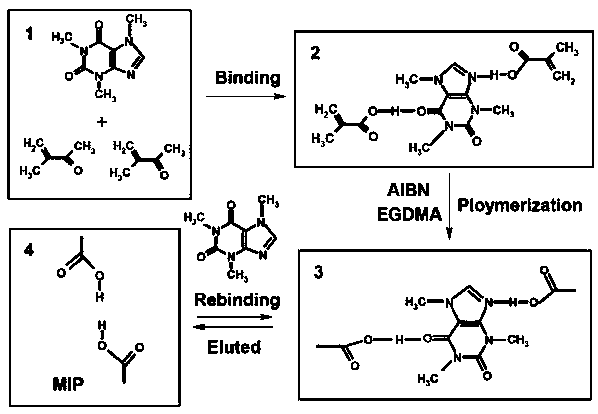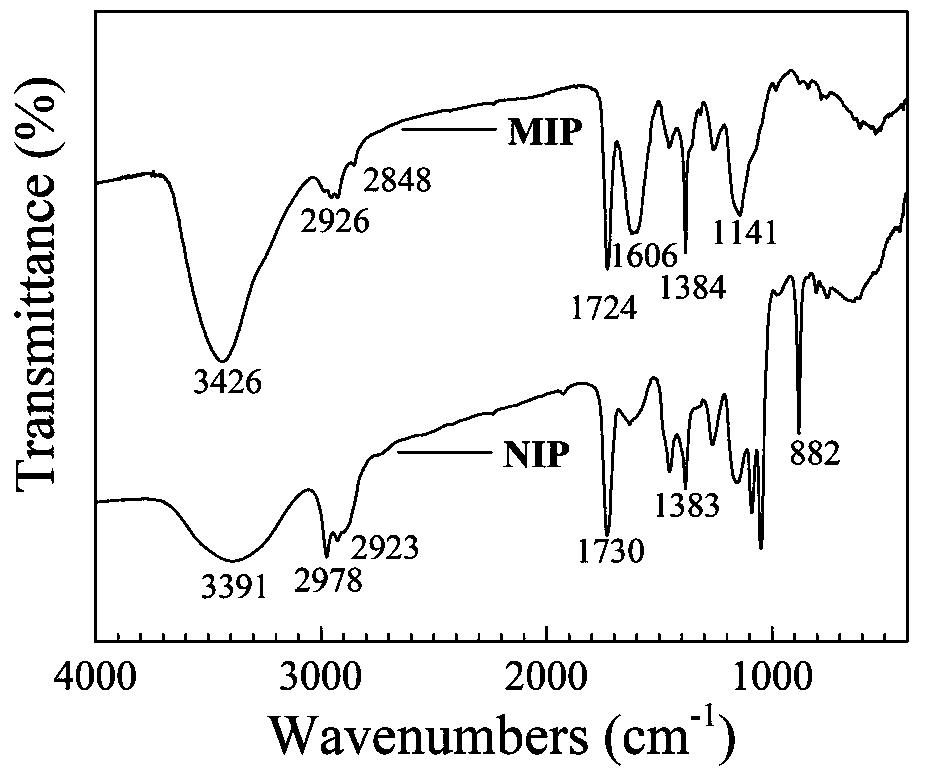Preparation method for artificial antibody for caffeine detection
An artificial antibody, caffeine technology, applied in the field of material science, can solve problems such as poor selectivity, and achieve the effect of easy operation, high sensitivity and high specificity
- Summary
- Abstract
- Description
- Claims
- Application Information
AI Technical Summary
Problems solved by technology
Method used
Image
Examples
preparation example Construction
[0056] A method for preparing an artificial antibody for caffeine detection, characterized in that: the artificial antibody elutes the imprinted molecules located in the polymer imprinted shell, and the inner part of the imprinted shell has the structure and size of the imprinted molecule With a hole structure complementary to the functional group, the artificial antibody that elutes the imprinted molecule has a specific recognition site for the enzyme-labeled antigen molecule, and realizes selective recognition of the enzyme-labeled antigen molecule. The luminescence method realizes trace detection of enzyme-labeled antigen molecules. The preparation process of the above-mentioned artificial antibody includes the following four steps:
[0057] The first step is the oxidation of horseradish peroxidase: Weigh 4 ~ 6mg of horseradish peroxidase and dissolve it in 1 ~ 3mL of freshly prepared acetate buffer solution containing sodium periodate, and react in the dark at room temperat...
specific Embodiment
[0061] Dissolving caffeine in acetonitrile solution reacts with functional monomer methacrylic acid, and the amino group and carbonyl group in the molecular structure of caffeine and the carboxyl group of methacrylic acid are arranged in the form of hydrogen bonds to form a hydrogen bond adduct. A cross-linking agent ethylene glycol dimethacrylate and an initiator azobisisobutyronitrile are added to the hydrogen bond adduct to obtain molecular polymer microspheres imprinted with caffeine. Using V (methanol): V (acetic acid) = 9: 1 solution to wash off the imprinted molecules to obtain molecularly imprinted polymer microspheres with selective recognition of caffeine artificial antibody.
[0062] The first step is the oxidation of horseradish peroxidase: Weigh 5 mg of horseradish peroxidase and dissolve it in 2 mL of freshly prepared acetate buffer containing sodium periodate, react in the dark for 30 minutes at room temperature, and add an appropriate amount of glycerol After c...
PUM
| Property | Measurement | Unit |
|---|---|---|
| adsorption capacity | aaaaa | aaaaa |
| adsorption capacity | aaaaa | aaaaa |
Abstract
Description
Claims
Application Information
 Login to View More
Login to View More - R&D
- Intellectual Property
- Life Sciences
- Materials
- Tech Scout
- Unparalleled Data Quality
- Higher Quality Content
- 60% Fewer Hallucinations
Browse by: Latest US Patents, China's latest patents, Technical Efficacy Thesaurus, Application Domain, Technology Topic, Popular Technical Reports.
© 2025 PatSnap. All rights reserved.Legal|Privacy policy|Modern Slavery Act Transparency Statement|Sitemap|About US| Contact US: help@patsnap.com



